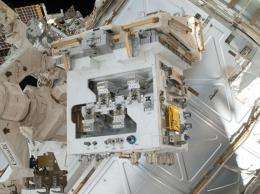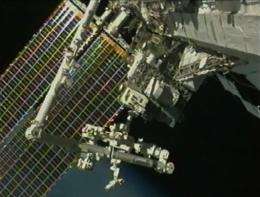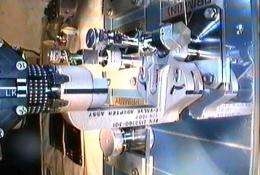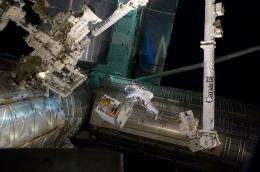The Robotic Refueling Mission (RRM) module on the International Space Station before it was installed on its permanent platform. Credit: NASA
NASA completed another successful round of Robotic Refueling Mission (RRM) operations on the International Space Station with the Canadian Dextre robot and RRM tools, leaving the RRM module poised for the highly-anticipated refueling demonstration scheduled for late summer 2012.
A joint effort between NASA and the Canadian Space Agency (CSA), RRM is an external station experiment designed to demonstrate the technologies, tools, and techniques needed to robotically repair and refuel satellites in orbit, especially those not built with servicing in mind. RRM results and lessons learned are reducing the risks associated with satellite servicing and bolstering the foundation for future robotic servicing missions.
“Now that these tasks are complete, our eyes are now set on the RRM refueling demonstration and the eventual benefits that it will bring to the aerospace industry,” says Benjamin Reed, deputy project manager of the Satellite Servicing Capabilities Office at NASA's Goddard Space Flight Center in Greenbelt, Md.
“Every year, functional satellites providing weather, communications, and other essential services are retired because they have reached the end of their fuel supply,” continued Reed. “We envision a future where refueling services extend the lifespan of these satellites and increase capacity for users and consumers. RRM is designed to prove this robotic refueling technology, and we are looking forward to practicing this task in late summer 2012.”
Satellite-servicing capabilities function like a reliable toolkit to help humans build, repair, and maintain critical space assets. Repair and refueling technologies similar to the ones demonstrated by RRM could be used to extend the lifespan of existent satellites, support the assembly of large structures on orbit, and mitigate orbital debris, among other benefits. In turn, these advances could make spaceflight more efficient, sustainable, and cost effective.
RRM (center, on platform) uses Canadarm2 and the Canadian Dextre robot (left and bottom, foreground) to demonstrate satellite-servicing tasks. Credit: NASA/CSA
The RRM Gas Fittings Removal task that occurred June 19-22, represents the second on-orbit use of the RRM tools developed at NASA’s Goddard Space Flight Center. During the task, robot operators at NASA’s Johnson Space Center remotely controlled Dextre to retrieve the RRM Multifunction Tool. They executed the tasks required to remove representative fittings found on many spacecraft to fill various fluids and gases prior to launch.
“The International Space Station (ISS) has been an excellent test bed for demonstrating satellite-servicing technology,” says Reed. “We are extremely grateful to the space station and to our essential partners, the Canadian Space Agency, for their support.”
RRM's Multifunction Tool with its T-Valve Adapter closes in to retrieve the T-Valve on the RRM module. Credit: NASA
“Accurately simulating space on the ground is very costly and fraught with compromises. So to be able to develop our satellite servicing strategies in space, with all the essential services (power, command, telemetry, robotics) provided, makes for better technology development for fewer dollars. Sign me up as a charter member of the ISS Fan Club.”
Dextre, the space station’s twin-armed robotic “handyman,” was developed by the CSA to perform delicate assembly and maintenance tasks on the station’s exterior as an extension of its 57-foot-long (17.6 meter) robotic arm, Canadarm2. CSA wrote the software to control Dextre during RRM operations.
On July 12, 2011, spacewalking astronauts Mike Fossum and Ron Garan successfully transferred the Robotic Refueling Mission module from the Atlantis shuttle cargo bay to a temporary platform on the International Space Station's Dextre robot. Credit: NASA
RRM operations are monitored and remotely controlled by flight controllers at NASA’s Goddard Space Flight Center, Johnson Space Center, Marshall Space Flight Center, and the Canadian Space Agency’s control center in St. Hubert, Quebec.
Drawing upon 20 years of experience servicing the Hubble Space Telescope, the Satellite Servicing Capabilities Office initiated the development of RRM in 2009. RRM results to date were recently presented at the Second International Workshop on On-Orbit Satellite Servicing, hosted and held at NASA’s Goddard Space Flight Center May 30-31.
Satellite servicing with astronauts is not new for NASA. Skylab, NASA’s first space station, was repaired in space in 1973. Solar Maximum and Syncom IV, with help from the shuttle, were successfully repaired in the 1980’s. In the 1990’s NASA serviced the Compton Gamma Ray Observatory, Intelsat VI, and executed a series of highly successful servicing missions to the Hubble Space Telescope.
More recently, human and robotic servicing capabilities have contributed to the assembly, upkeep, repair, and maintenance of the space station. With RRM, NASA is maturing specific robotic satellite-servicing technologies needed for the development of future robotic servicing spacecraft.
Provided by NASA

























